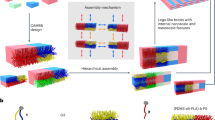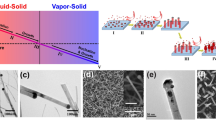Abstract
Nanostructured materials are attractive to researchers because of their unique optical, magnetic, thermodynamic, electrical, mechanical, and chemical properties. Controlling the morphology of nanomaterials could provide structural systems for a wide range of technologies. As a result, the development of nanofabrication techniques that are convenient and offer design flexibility is the subject of many studies. In order to progress beyond the conventional morphologies, we have turned to hydrogels, which can serve as organic templates for nanoscale objects with continuous microstructures. Transmission electron microscopy showed that the obtained nanonetwork had a continuous microstructure, which was several microns in length and width, with a cross-sectional diameter of 5–10 nm synthesized from a 35-g hexamethylenetetramine solution and a 1.5 g Zn(NO3)2 solution, and the cross-sectional diameter can be adjusted from 5 to 200 nm by controlling the concentration of the Zn(NO3)2 solution. Our results also showed that the nanostructures based on a superabsorbent polymer template could be controlled easily in terms of size and morphology by changing the concentration of the reaction solution. This protocol could be easily extended to synthesize a variety of nanostructured materials with novel morphologies.







Similar content being viewed by others
References
Burda C, Chen X, Narayanan R, El-Sayed MA (2005) Chemistry and properties of nanocrystals of different shapes. Chem Rev 105:1025–1102
Carny O, Shalev DE, Gazit E (2006) Fabrication of coaxial metal nanocables using a self-assembled peptide nanotube scaffold. Nano Lett 6:1594–1597
Caruso F (2001) Nanoengineering of particle surfaces. Adv Mater 13:11–22
Chowdhury EH, Akaike T (2007) High performance DNA nano-carriers of carbonate apatite: multiple factors in regulation of particle synthesis and transfection efficiency. Int J Nanomed 2:101–106
Deng Z, Mao C (2003) DNA-templated fabrication of 1D parallel and 2D crossed metallic nanowire arrays. Nano Lett 3:1545–1548
Jhon MS, Andrade JD (1973) Water and hydrogels. J Biomed Mater Res 7:509–522
Kijima T, Yoshimura T, Uota M, Ikeda T, Fujikawa D, Mouri S, Uoyama S (2004) Noble-metal nanotubes (Pt, Pd, Ag) from lyotropic mixed-surfactant liquid-crystal templates. Angew Chem Int Ed Engl 43:228–232
Knez M, Bittner AM, Boes F, Wege C, Jeske H, Maiβ E, Kern K (2003) Biotemplate synthesis of 3-nm nickel and cobalt nanowires. Nano Lett 3:1079–1082
Murphy CJ, Jana NR (2002) Controlling the aspect ratio of inorganic nanorods and nanowires. Adv Mater 14:80–82
Reches M, Gazit E (2003) Casting metal nanowires within discrete self-assembled peptide nanotubes. Science (New York, NY) 300:625–627
Shenton W, Douglas T, Young M, Stubbs G, Mann S (1999) Inorganic-organic nanotube composites from template mineralization of tobacco mosaic virus. Adv Mater 11:253–256
Sone ED, Zubarev ER, Stupp SI (2002) Semiconductor nanohelices templated by supramolecular ribbons. Angew Chem Int Ed 41:1705–1709
Tsukamoto R, Muraoka M, Seki M, Tabata H, Yamashita I (2007) Synthesis of CoPt and FePt 3 Nanowires Using the Central Channel of Tobacco Mosaic Virus as a Biotemplate. Chemistry of Materials, ACS 19:2389–2391
Wang H, Patil AJ, Liu K, Petrov S, Mann S, Winnik MA, Manners I (2009) Fabrication of continuous and segmented polymer/metal oxide nanowires using cylindrical micelles and block comicelles as templates. Adv Mater 21:1805–1808
Wang H-W, Zhao T-B, Lu G-Z, Zhang S, Miao C, Weia X-F, Li F-Y (2011) Novel Micro/nanostructures from a Double Network Gel. J Chin Chem Soc 58:282–285
You C-C, Chompoosor A, Rotello VM (2007) The biomacromolecule-nanoparticle interface. Nano Today 2:34–43
Acknowledgments
This research was supported by the Fundamental Research Funds for the Central Universities (N110323003) and State Key Laboratory of Chemical Resource Engineering, Beijing University of Chemical Technology (CRE-2012-C-203). The Natural Science Foundation of Hebei Province under Grant No.B2014501120.
Author information
Authors and Affiliations
Corresponding author
Electronic supplementary material
Below is the link to the electronic supplementary material.
Rights and permissions
About this article
Cite this article
Wang, H., Zhu, Y., Wei, X. et al. New protocol for synthesis of new nanomaterials with continuous 3D networks. J Nanopart Res 16, 2409 (2014). https://doi.org/10.1007/s11051-014-2409-z
Received:
Accepted:
Published:
DOI: https://doi.org/10.1007/s11051-014-2409-z




